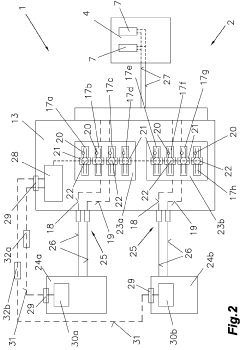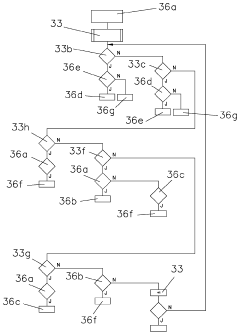Check Valves With Integrated Monitoring And Diagnostics
Check Valves Technology Background And Goals
Additionally, it is crucial to highlight the geographical distribution of expertise and resources in this domain, shedding light on the regions or countries that have emerged as leaders or potential hotspots for future development. By thoroughly assessing the present landscape, we can gain valuable insights into the areas that require focused attention and investment to overcome existing limitations and drive innovation.
Check Valves Market Demand Analysis
- Market Size and Growth
The global check valve market is projected to reach $7.2 billion by 2027, growing at a CAGR of 4.8% from 2022 to 2027. The increasing demand from industries like oil & gas, chemical, and power generation is driving market growth. - Industry Trends
Key trends shaping the check valve market include:- Rising adoption of smart valves with integrated monitoring and diagnostics
- Increasing focus on preventive maintenance and asset management
- Growing demand for corrosion-resistant and high-performance valves
- Regional Analysis
Asia Pacific is expected to be the fastest-growing region due to rapid industrialization and infrastructure development. North America and Europe are mature markets, driven by stringent regulations and demand for advanced valve technologies. - Application Insights
The oil & gas industry is a major consumer of check valves, followed by chemical, power generation, and water & wastewater treatment sectors. The demand is driven by the need for reliable and efficient flow control solutions.
Check Valves Technology Status And Challenges
- Valve Monitoring Challenges
Integrating monitoring systems into valves poses technical hurdles, such as sensor integration, data transmission, and power supply. - Harsh Environments
Check valves often operate in extreme conditions, like high temperatures, pressures, and corrosive media, complicating monitoring system design. - Reliability Concerns
Monitoring systems must be highly reliable to ensure accurate valve diagnostics and prevent false alarms or missed faults. - Data Analysis Complexity
Interpreting sensor data to diagnose valve issues requires advanced algorithms and expertise in valve behavior modeling. - Integration with Existing Systems
Seamless integration of valve monitoring with plant control systems and maintenance workflows is crucial for effective implementation.
Check Valves Current Technical Solutions
01 Check Valve Monitoring Systems
Systems and methods for monitoring check valve condition and performance, involving sensors, data acquisition, and analysis techniques to detect issues like leakage, stuck valves, or improper operation.- Monitoring and Diagnostic Systems: Systems and methods for monitoring and diagnosing check valve condition, involving sensors and analysis of parameters like pressure, flow rate, vibration, and acoustic signals to detect issues such as leakage, blockage, or wear.
- Predictive Maintenance and Fault Detection: Techniques for predictive maintenance and fault detection in check valves, analyzing sensor data to identify patterns or anomalies indicating potential issues or impending failures, enabling preventive maintenance and improved reliability.
- Wireless Monitoring and Remote Diagnostics: Wireless monitoring and remote diagnostic systems for check valves, allowing real-time monitoring and analysis of valve performance from a remote location using wireless sensors and communication technologies.
- Integrated Monitoring and Control Systems: Integrated monitoring and control systems for check valves, combining monitoring, diagnostics, and control functions for automated adjustment or actuation based on monitored data and analysis, improving efficiency and reliability.
- Machine Learning and AI for Diagnostics: Application of machine learning and artificial intelligence techniques for check valve diagnostics, involving training algorithms on historical data to develop predictive models and intelligent systems for accurate diagnosis and failure prediction.
02 Check Valve Diagnostic Techniques
Techniques for diagnosing and troubleshooting check valve issues, including methods for detecting and locating leaks, identifying malfunctions, and analyzing performance data, using approaches like acoustic monitoring or pressure measurements.Expand Specific Solutions03 Wireless Monitoring and Control
Systems and methods for wireless monitoring and control of check valves in remote or inaccessible locations, using wireless communication technologies and remote data acquisition and control capabilities for real-time monitoring and remote operation.Expand Specific Solutions04 Predictive Maintenance and Condition Monitoring
Techniques for predictive maintenance and condition monitoring of check valves, involving data analysis, machine learning, and predictive models to anticipate failures or degradation, optimizing maintenance schedules and improving system reliability.Expand Specific Solutions05 Integration with Control Systems
Methods and systems for integrating check valve monitoring and diagnostics with industrial control systems, process automation systems, or SCADA systems, allowing for centralized monitoring, control, and optimization of valve operations.Expand Specific Solutions
Check Valves Main Player Analysis
Siemens AG
Robert Bosch GmbH
Check Valves Key Technology Interpretation
- The integrated valve has monitoring and diagnostic capabilities, allowing data exchange with connected systems for better process control and maintenance.
- The integrated valve design enables temperature control of shaping tools in various manufacturing processes, such as injection molding, die casting, and extrusion.
- The integrated valve system can be connected to external systems, enabling data exchange and potentially enabling remote monitoring and control.
Environmental Impact of Check Valves Monitoring And Diagnostics Integration
The integration of monitoring and diagnostics capabilities into check valves can have a significant environmental impact. Real-time monitoring allows for early detection of valve issues, enabling timely maintenance and repairs, which can prevent leaks and emissions. Predictive diagnostics help optimize valve operation and extend service life, reducing resource consumption and waste. Additionally, improved valve reliability minimizes the risk of process disruptions and associated environmental incidents. Overall, this technology promotes resource efficiency, reduces emissions, and supports sustainable industrial operations by enhancing equipment performance and lifespan.



